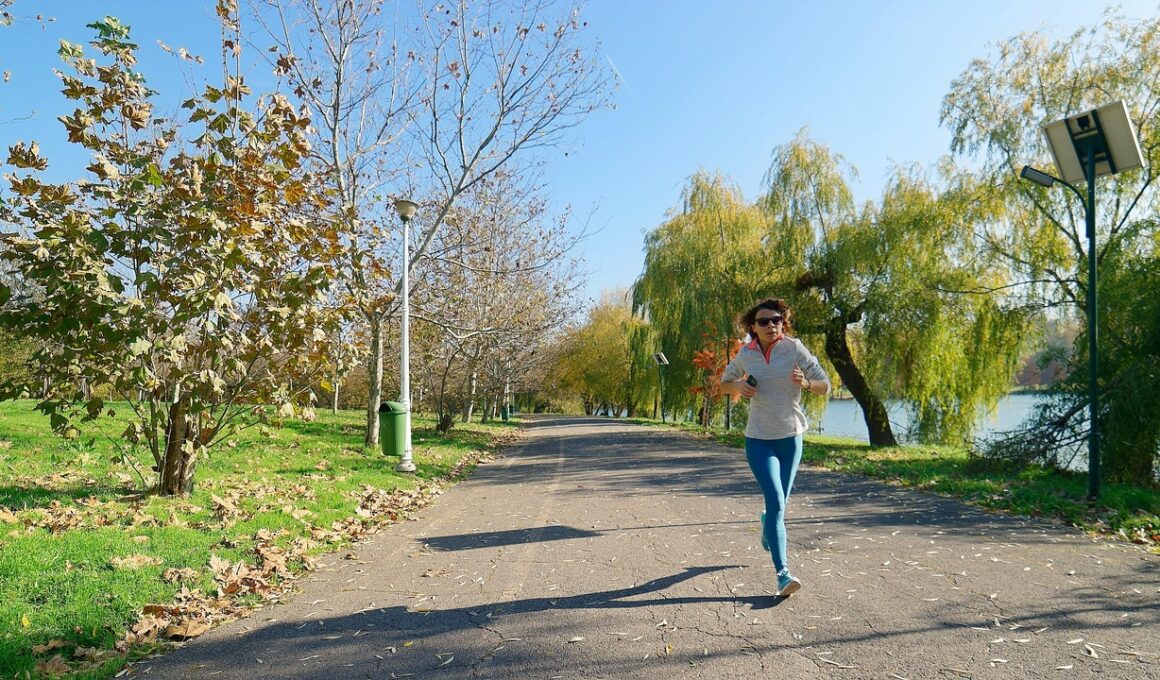The Benefits of Outdoor Exercise for Energy Efficiency
Engaging in outdoor exercise offers numerous benefits not just for our health but also for promoting energy efficiency. The simple act of stepping outside to work out can help reduce energy demands associated with indoor gyms. Outdoor spaces, such as parks and trails, encourage smaller groups to work out together, which minimizes the overhead consumption per person. Additionally, the natural environment provides fresh air and sunlight, both of which contribute positively to our mental well-being and motivation to exercise. This invigorating atmosphere can lead to longer workouts, better performance, and improved cardiovascular health. Environmentally conscious workouts lessen the reliance on energy-consuming machinery found indoors. Furthermore, exercising outdoors in nature can inspire awareness of local ecosystems and encourage eco-friendly habits. Choosing outdoor spaces for exercise has significant benefits, including reduced electricity usage for lighting and temperature control in indoor facilities. This, in turn, helps to conserve energy resources, which contributes to a more sustainable lifestyle. Hence, making outdoor workouts a routine could positively impact your physical health while fostering environmentally friendly attitudes.
Building Community and Awareness
Outdoor exercise not only promotes personal fitness but also fosters a sense of community. Participating in group activities such as running clubs or yoga in the park can bring people together, creating camaraderie and collaborative fitness goals. These communal activities help raise awareness about environmental fitness and the importance of energy efficiency. Community events often highlight local trails and parks, encouraging their usage and helping preserve these natural spaces. By exercising outside regularly, individuals directly witness changes in their environment, which may enhance their commitment to sustainability. Increased public engagement in outdoor activities can lead to collective efforts in maintaining these spaces while also advocating for more energy-efficient facilities. Activities such as clean-up days or tree-planting initiatives often emerge from these groups, emphasizing the environmental aspect of fitness. As people gather, they share tips on energy-efficient habits, creating a ripple effect. Knowledge sharing encourages more residents to adopt eco-friendly practices in their daily lives. This shift towards sustainable living begins within local communities, making outdoor exercise a key player in increasing awareness and motivating change.
Moreover, outdoor exercise can drastically reduce the carbon footprint associated with fitness routines. Traditional indoor workout routines often involve the use of electricity-powered equipment that draws energy from the grid, contributing to higher emissions. Conversely, outdoor workouts utilize minimal resources, taking advantage of natural elements like sunlight and fresh air. Cycling, running, and hiking are excellent outdoor workouts that require no additional energy to produce. By choosing these activities, individuals can significantly decrease their overall energy consumption. Furthermore, enjoying nature has intrinsic benefits that help in the preservation of natural resources. Local parks and open spaces serve as critical ecosystems that filter air and provide habitat for numerous species. Exercising outdoors encourages individuals to appreciate and protect these natural environments, thus promoting consciousness about sustainability. When individuals adopt outdoor fitness routines, they often begin linking economic efficiency to environmental health. Increasing awareness of climate impact directly correlates to individuals’ acceptance of more sustainable practices, both in fitness and daily lifestyles. By consciously opting for outdoor workouts, people can redefine their relationship with fitness while contributing positively to environmental conservation efforts.
Health Benefits That Promote Eco-Friendly Choices
Outdoor exercise not only contributes to physical health but also enhances overall well-being, driving individuals to make eco-friendly lifestyle choices. Studies have shown that exercising in nature helps reduce stress and boost mood through increased exposure to sunlight and natural scenery. When individuals feel better, their awareness of environmental issues often grows, leading to adjustments in personal habits and daily choices. For instance, outdoor workouts can motivate individuals to use less fuel-consuming transport methods, such as walking or cycling instead of driving. Additionally, being immersed in nature promotes a sense of ownership and responsibility over local ecosystems. This closeness to nature can inspire individuals to adopt environmentally conscious habits, such as reducing waste, recycling, and conserving water. Using sustainable gear for outdoor activities further emphasizes this shift towards eco-awareness. Many fitness enthusiasts now seek environmentally friendly products, including clothing made from organic materials and biodegradable gear. This trend exemplifies how activities like running or hiking outside can stimulate broader environmental initiatives. The connection between physical fitness and eco-friendly living creates a powerful incentive that can contribute significantly to sustainable practices within communities.
In addition, outdoor exercise aligns perfectly with the principles of energy efficiency by encouraging movement in natural environments. Engaging with local surroundings helps people forge a deeper connection with their community, while also encouraging exploration of different terrains, contributing to a more active lifestyle. These activities foster rigorous physical health, improving cardiovascular functions, and boosting overall energy levels. As people experience invigorating outdoor workouts, they are more likely to prefer exercising outside rather than inside energy-consuming facilities. This shift catalyzes a reduced dependence on gyms, leading to less power consumption overall. Furthermore, outdoor workouts often necessitate less travel, especially when individuals discover local areas suitable for exploration. This minimized travel not only cuts down energy costs but also improves overall air quality. Choosing to exercise on foot or by bike contributes directly to lowering vehicular emissions. Incorporating these practices into daily routines offers vast potential for promoting energy efficiency within communities. Overall, turning to outdoor exercise opens pathways to healthier living while supporting sustainable initiatives. By making conscious choices about exercising outdoors, individuals can effectively contribute to both personal and environmental wellness.
The Role of Technology in Outdoor Workouts
While exercising outdoors inherently utilizes fewer energy resources, technology can also play an essential role in maximizing these benefits. Many fitness apps and gadgets now promote outdoor activities, allowing users to track their performance and connect with others engaged in similar pursuits. Utilizing technology in innovative ways fosters accountability and motivation, all while encouraging users to engage with local outdoor areas. Furthermore, many exercise apps offer insights into nearby parks and trails, allowing users to discover new places to work out. This discovery encourages individuals to utilize their local environment rather than defaulting to conventional fitness establishments. User-generated content sharing platforms enable participants to share their experiences and promote the significance of outdoor workouts. This sense of community fosters a supportive network for sustainability and health enthusiasts alike. As users document achievements in nature, it encourages more people to participate. By combining technology with outdoor exercise, individuals can enhance their experiences while promoting energy-efficient choices. The incorporation of virtual challenges linked to environmental awareness can further stimulate a shift toward sustainable training practices among wider audiences.
In conclusion, participating in outdoor exercise not only benefits individual health but also prioritizes energy efficiency and environmental consciousness. By making the choice to engage in activities like walking, jogging, or cycling in open spaces, individuals are taking proactive steps toward reducing their carbon footprint and conserving energy resources. The psychological benefits of outdoor workouts further catalyze interest in sustainable living, inspiring individuals to be more mindful of their habits. Communities can gain strength and awareness through shared outdoor fitness experiences, reinforcing collective commitment to eco-friendly practices. Emphasizing the importance of outdoor exercise will help foster greater participation in sustainability initiatives; leading to healthier individuals and healthier ecosystems. As environmental fitness concerns grow worldwide, adopting outdoor activities can significantly mitigate harmful impacts. Prioritizing outdoor exercises reframe energy efficiency discussions, making community participation a prioritized goal. Looking beyond gym walls opens a doorway toward harnessing nature’s benefits for our well-being, while also promoting eco-friendly initiatives. Therefore, integrating outdoor workouts into our daily lives serves as a reminder of our interconnectedness with natural environments and our responsibility to protect them.
By choosing outdoor exercise as a routine, an individual can make significant strides in reducing energy consumption while enhancing personal health. The regular practice of exercising outdoors fosters a holistic approach that unites fitness with sustainable living. The mutual benefits create a healthy synergy, providing motivation and inspiration to pursue lives that honor the planet. Improved physical health often results from spending time outdoors in natural settings, as exercising can combat mental fatigue. This is especially important considering the increasing prevalence of stress due to urbanization. Regular outdoor fitness regimens are essential for cultivating a sense of community as people engage with local parks and recreational activities. By taking part in outdoor classes or events, individuals contribute to the care and preservation of green spaces; this ultimately enhances the aesthetic value of neighborhoods. Outdoor activity also allows for exploration of new environments, making workouts exciting and varied. Meanwhile, sharing these experiences can reinforce ongoing community spirit and invite new members into the fold. Ultimately, embracing outdoor exercise not only reshapes our physical lives but also aligns our energy-efficient goals with broader ecological responsibility.


